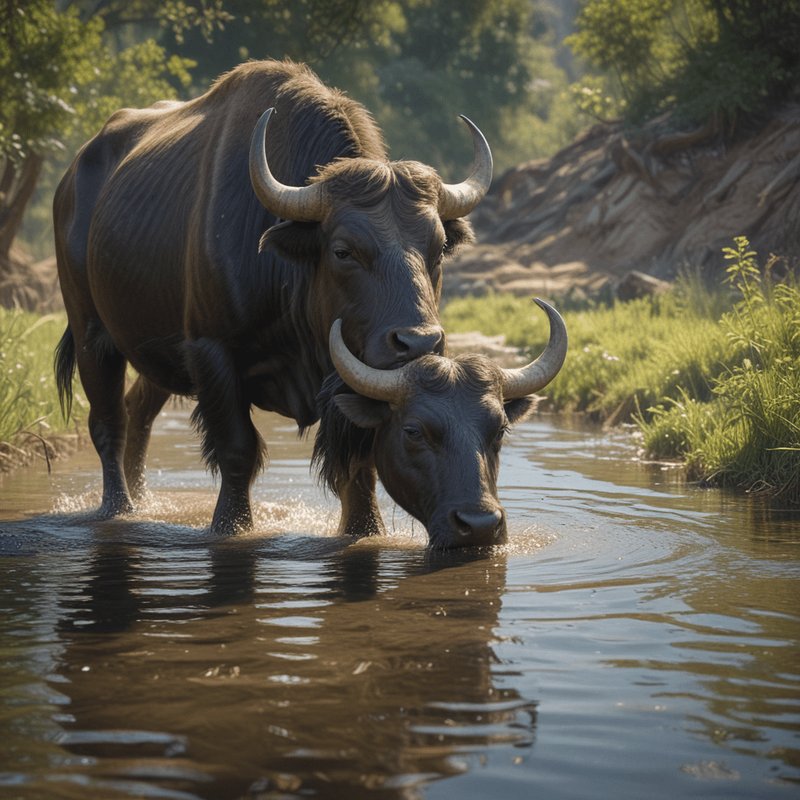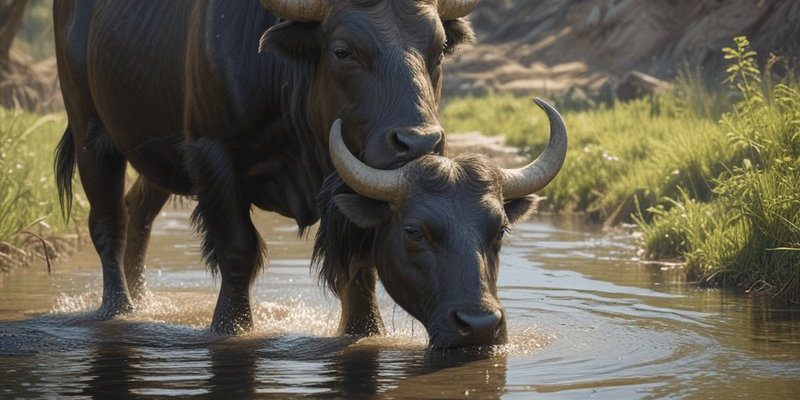
Let’s dive deeper into how the water buffalo is represented in various cultural narratives and folklore. Just like a good story has layers, so does the water buffalo’s significance across different societies. You might be surprised at how an animal that often roams rural landscapes has such a rich tapestry of meanings woven into it.
The Water Buffalo in Asian Cultures
Water buffaloes hold a cherished spot in many Asian countries, particularly in nations like India, Vietnam, and China. In these cultures, they symbolize hard work and agricultural prosperity. Farmers often rely on them for tilling fields and assisting in harvests. This strong bond between farmer and animal goes beyond mere utility; it’s steeped in tradition and custom.
For instance, in Vietnam, the water buffalo is celebrated during the Lunar New Year festival. This time of year is filled with rituals that honor ancestors and important agricultural figures. The water buffalo is seen as a pivotal part of these traditions, embodying the spirit of perseverance and dedication that many Vietnamese people value.
In India, specifically in rural regions, you might find stories where water buffaloes are portrayed as wise creatures that guide farmers through difficulties, akin to how elders impart wisdom to younger generations. Here’s the thing: these narratives foster a deep respect for the animal, connecting it to the very identity of the communities that rely on them.
Folklore and Myths Surrounding the Water Buffalo
You might be wondering about the stories that swirl around the water buffalo. In many cultures, folklore often elevates the animal to a mythical status. In Thailand, for example, there’s a popular tale about a water buffalo who saves a village from a flood. In this story, the buffalo uses its strength to help the villagers transport their belongings to safety. This kind of narrative highlights the buffalo’s role as a protector and savior.
Similarly, in Chinese folklore, the water buffalo is often associated with the Earth element. Because of this, it symbolizes stability, nourishment, and abundance. In some stories, it is believed that the buffalo helps farmers grow bountiful crops, highlighting its importance in agrarian societies. These narratives not only celebrate the animal’s physical strength but also its moral integrity and protective nature.
As you dig deeper into these myths, you’ll notice a common thread: the water buffalo is often portrayed as a humble hero. It doesn’t seek glory but instead works diligently for the benefit of others. This resonates with the values of many cultures that appreciate modesty and hard work.
The Water Buffalo in Religious Contexts
In various religions, the water buffalo finds its place as a significant creature with spiritual connotations. For instance, in Hinduism, the water buffalo is associated with several deities, particularly related to agriculture and prosperity. It is often depicted in rituals and celebrations related to abundance and fertility. This not only reinforces the animal’s role in sustaining human life but also elevates it to a sacred status.
In Buddhism, the water buffalo represents diligence and the balance between the material and spiritual worlds. Its ability to thrive in both wet and dry environments symbolizes adaptability—a trait that is highly valued in spiritual teachings. Buddhists often reflect on how the water buffalo’s hard work can serve as a metaphor for their own life’s journey toward enlightenment.
By representing important qualities like humility and dedication, the water buffalo helps illustrate key teachings in these religions. When you think of it this way, the animal becomes more than just a farm helper; it becomes an integral part of the spiritual and cultural fabric.
Water Buffalo in Festivals and Celebrations
Cultural festivals around the world frequently showcase the water buffalo in various forms, celebrating its contributions to agriculture and community life. For example, in India, the Pongal festival honors nature’s bounty, where the water buffalo is celebrated for its role in starting the agricultural cycle. During this time, special prayers and offerings are made to express gratitude for the buffalo’s labor.
Similarly, in the Philippines, the Buffalo Festival is a vibrant celebration that honors the importance of the water buffalo in rural life. This lively event features parades, dances, and contests, all centered around these magnificent animals. It’s a way for communities to come together, respect their agricultural roots, and instill a sense of pride in their local traditions.
These festivals are not just about agriculture; they unite people, reinforcing a sense of community and shared identity. When communities celebrate the water buffalo, they’re also celebrating resilience, hard work, and the spirit of togetherness that these animals represent.
Environmental Significance of Water Buffalo
Beyond cultural narratives, the water buffalo plays a crucial role in environmental management. Their grazing habits can actually benefit local ecosystems. By eating certain grass and vegetation, they help maintain the balance of habitats. This is especially important in wetland areas, where their activity can encourage the growth of diverse plant species.
Moreover, water buffalo are often used in sustainable farming practices. They can plow fields more gently than modern machinery, reducing soil compaction and promoting healthy soil ecosystems. This not only benefits the crops but also contributes to long-term agricultural viability. It’s like a timeless dance between tradition and sustainability, showcasing the buffalo’s dual role as both a worker and a benefactor of the environment.
Communities around the world are beginning to recognize this significance, and there’s a growing emphasis on preserving water buffalo populations. By protecting these animals, cultures can safeguard their agricultural heritage while also promoting environmental stewardship.
Modern Representations of Water Buffalo
In recent years, the water buffalo has found its way into modern media, from cartoons to documentaries, often portrayed as an endearing character. This representation serves to remind us of their integral role in society while bringing attention to the challenges they face in today’s rapidly changing world.
In some documentaries, you might see heartwarming stories of farmers and their water buffalo, emphasizing the connection that spans generations. These visuals not only highlight the bond between humans and animals but also raise awareness about agricultural challenges and the need for sustainable practices.
Additionally, social media has been a game-changer, allowing people to share stories and images of water buffalo across the globe. By doing so, they help foster awareness about these animals, their cultural significance, and the importance of supporting local agriculture. This modern representation can inspire younger generations to appreciate and carry forward the traditions tied to these majestic creatures.
The Future of Water Buffalo in Culture
As we march forward into an ever-evolving world, the cultural significance of the water buffalo remains relevant. It’s crucial to keep these stories alive, as they reflect not only the past but also the challenges and opportunities of the future. With modernization impacting traditional farming methods, there’s a pressing need to advocate for both the animal and the cultural practices linked to it.
Engaging with the cultural and environmental importance of the water buffalo can inspire actions that benefit both communities and ecosystems. By incorporating sustainable farming practices and celebrating festivals centered around these animals, societies can ensure that the legacy of the water buffalo continues to thrive.
As we look ahead, the water buffalo can serve as a symbol of resilience in the face of change. Recognizing its role in culture and folklore helps remind us of the values of hard work, community, and respect for nature—all of which can guide us toward a more sustainable future.
In conclusion, the water buffalo is more than just a farm animal; it’s a cultural icon deeply embedded in the stories, festivals, and values of various societies. By understanding its representations in culture and folklore, we gain insight into the human experience and the lessons that connect us all. So, the next time you see a water buffalo, remember the rich history and vibrant stories it carries, reminding us that every creature has its place in the tapestry of life.

